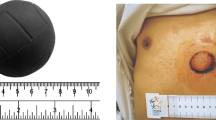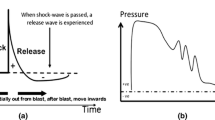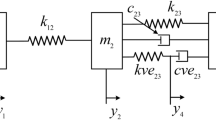Abstract
Bio-simulants and finite element (FE) models have been used to investigate internal injuries caused by external impacts. As the collaboration between humans and industrial robots increases, it is important to understand the expected injuries or damage caused by collaborative robots. In this paper, FE models of the human chest were built to investigate injuries caused by low-speed non-penetrating blunt impacts from collaborative robots. The FE models were validated by comparing them with experimental results. The validated FE models were then used to calculate the maximum force and deformation that would be experienced by the human chest under different impact conditions. The results of the FE analysis were compared with relevant real human test studies.
Similar content being viewed by others
Abbreviations
- FE :
-
Finite element
- HRC :
-
Human-robot collaborative
- DOF :
-
Degree of freedom
- OG :
-
Ogden
- MR :
-
Mooney-Rivlin
- V impact :
-
Impact velocity
- H drop :
-
Drop height
- LVDT :
-
Linear variable differential transformer
- TCP :
-
Tool center point
- PFL :
-
Power and force limit
- ASTM :
-
American Society for Testing and Materials
References
A. Kanazawa, J. Kinugawa and K. Kosuge,z Adaptive motion planning for a collaborative robot based on prediction uncertainty to enhance human safety and work efficiency, IEEE Transactions on Robotics, 35 (4) (2019) 817–830.
E. Guizzo and E. Ackerman, How rethink robotics built its new baxter robot worker, IEEE Spectrum, 2012 (2012) 18.
M. Bélanger-Barrette, Collaborative Robot, ROBOTIQ (2015).
M. Valori, A. Scibilia, I. Fassi, J. Saenz, R. Behrens, S. Herbster, C. Bidard, E. Lucet, A. Magisson, L. Schaake, J. Bessler, G. B. Prange-Lasonder, M. Kühnrich, A. B. Lassen and K. Nielsen, Validating safety in human-robot collaboration: standards and new perspectives, Robotics, 10 (2021) 65, https://doi.org/10.3390/robotics10020065.
S. Robla-Gómez, V. M. Becerra, J. R. Llata, E. González-Sarabia, C. Torre-Ferrero and J. Pérez-Oria, Working together: a review on safe human-robot collaboration in industrial environments, IEEE Access, 5 (2017) 26754–26773, doi: https://doi.org/10.1109/ACCESS.2017.2773127.
N. G. Dagalakis, J. M. Yoo and T. Oeste, Human-robot collaboration dynamic impact testing and calibration instrument for disposable robot safety artifacts, Industry Robotics, 43 (3) (2016) 328–337.
J. Zhang, N. Yoganandan, F. A. Pintar and T. A. Gennarelli, Finite element analysis of penetrating head injury, Proceedings of the ASME 2003 International Mechanical Engineering Congress and Exposition, Advances in Bioengineering, Washington, DC, USA, 15–21 (2003) 193–194, https://doi.org/10.1115/IMECE2003-42978.
B. P. Kneubuehl, Wound Ballistics: Basics and Applications, 4th ed., Springer-Verlag (2011).
D. S. Cronin and C. Falzon, Characterization of 10 % ballistic gelatin to evaluate temperature, aging and strain rate effects, Exp. Mech., 51 (2010) 1197e206.
M. L. Fackler and J. A. Malinowski, Ordnance gelatin for ballistic studies, The American Journal of Foresnic Medicine and Pathology, 9 (1988) 218–219.
J. Jussila, Wound ballistic simulation: assessment of the legitimacy of law enforcement firearms ammunition by means of wound ballistic simulation, Thesis, Second Department of Surgery, University of Helsinki, Finland (2005).
N. R. Maiden, W. Fisk, C. Wachsberger and R. W. Byard, Ballistics ordnance gelatine - how different concentrations, temperatures and curing times affect calibration results, J. Forensic Leg Med., 34 (2015) 145–150, doi: https://doi.org/10.1016/j.jflm.2015.05.019.
A. Airoldi and B. Cacchione, Modelling of impact forces and pressures in lagrangian bird strike analyse, Int. J. Impact. Eng., 32 (2006) 1651–1677.
G. J. Appleby Thomas, P. J. Hazell, J. M. Wilgeroth, C. J. Shepherd, D. C. Wood and A. Roberts, On the dynamic behavior of three readily available soft tissue simulants, J. Appl. Phys., 109 (084701) (2011) 1–6.
D. S. Cronin and C. Falzon, Dynamic characterization and simulation of ballistic gelatin, Proceedings of the SEM Annual Conference, Society for Experimental Mechanics, New Mexico, USA (2009).
L. Liu, Z. Jia, X. L. Ma and Y. R. Fan, Analytical and experimental studies on the strain rate effects in penetration of 10 wt % ballistic gelatin, J. Phys. Conf. Ser., 451 (2013) 012035.
ISO/TS 15066:2016, Robots and Robotic Devices - Collaborative Robots, ISO, 2 (2016) 1–5.
C. Van Sligtenhorst, D. S. Cronin and G. Wayne Brodland, High strain rate compressive properties of bovine muscle tissue determined using a split Hopkinson bar apparatus, J. Biomech., 39 (10) (2006) 1852–1858, doi: https://doi.org/10.1016/j.jbiomech.2005.05.015.
S. Haddadin, A. Albu-Schäffer and G. Hirzinger, The role of the robot mass and velocity in physical human-robot interaction - part I: non-constrained blunt impacts, 2008 IEEE International Conference on Robotics and Automation Pasadena, CA, USA (2008) 19–23.
B. Giovanni, V. Rocco, P. Marcello and V. Gabriele, Chapter 6: Hyperelastic modeling of rubber-like photopolymers for additive manufacturing processes, Rapid Prototyping Technology-Principles and Functional Requirements, IntechOpen (2011).
R. W. Ogden, Large deformation isotropic elasticity: on the correlation of theory and experiment for incompressible rubberlike solids, Proceedings of the Royal Society of London A-326 (1972) 565–584.
ASTM D395-16, Standard Test Methods for Rubber Property Compression Set, ASTM International (2017).
F. Chen, R. Chen and B. Jiang, The adaptive finite element material point method for simulation of projectiles penetrating into ballistic gelatin at high velocities, Engineering Analysis with Boundary Elements, 117 (2020) 143–156, https://doi.org/10.1016/j.enganabound.2020.03.022.
GTE, Kraft-Druck-Messsysteme für kollaborierende Roboter, GTE, https://www.gte.de/produktuebersicht/kraftmesssystemefuer-kollaborierende-roboter/.
R. Behrens, G. Pliske, M. Umbreit, S. Piatek, F. Walcher and N. Elkmann, A statistical model to determine biomechanical limits for physically safe interactions with collaborative robots, Front. Robot. AI, 8 (2022) DOI: https://doi.org/10.3389/frobt.2021.667818.
J. Markarian, Mechanical testing suppliers strive for accuracy and reproducibility, Plastics, Additives and Compounding, 11 (3) (2009) 18–22.
ISO/TS 15066:2016, Robots and Robotic Devices - Collabo-Rative Robots, ISO (2016).
Z. Cheng, J. A. Smith, J. A. Pellettiere and S. M. Fleming, Considerations and experiences in developing a finite element buttock model for seating comfort analysis, SAE Technical Paper (2007) 2017-01-2458.
F. A. Urrea, F. Casanova, G. A. Orozco and J. J. García, Evaluation of the friction coefficient, the radial stress, and the damage work during needle insertions into agarose gels, J. Mech. Behav. Biomed. Mater., 56 (2016) 98–105, doi: https://doi.org/10.1016/j.jmbbm.2015.11.024.
Author information
Authors and Affiliations
Corresponding author
Additional information
Taeho Yang is a Manager at EPC BU/ Aerospace PU, HANYANG ENG CO., LTD. He received his Ph.D. degree in Mechanical Design and Mechatronics Engineering in 2015. From 2017 to 2019, he worked at National Institute of Standards and Technology as Guest Researcher. Dr. Yang’s research interests include impact analysis on structures with the hyper-elastic material and optimum design of structures in the aerospace industry.
Joonyong Chang serves as a Guest Researcher at the National Institute of Standards and Technology (NIST) in the United States. He earned his Master of Science degree in Mechanical Design Engineering from Chungnam National University, South Korea, in 2016. Between 2015 and 2018, Mr. Chang held a position at the Korea Atomic Energy Research Institute (KAERI), and from 2018 to 2019, he worked as a researcher at the Korea Advanced Institute of Science and Technology (KAIST). Mr. Chang’s research is primarily focused on assessing and analyzing the static and dynamic behavior of structures and materials under various conditions.
Nicholas G. Dagalakis received his M.S., Eng.D. and Ph.D. degrees from the Massachusetts Institute of Technology (MIT), Cambridge Massachusetts, U.S.A. and his Diploma from the National Technical University of Greece, Athens, in Mechanical and Electrical engineering. He has worked for two small companies, MIT as a Research Associate and the University of Maryland in College Park, as an Assistant Professor. He is a full-time research staff at the National Institute of Standards and Technology (NIST) in Gaithersburg Maryland. He has conducted research in Electrical Generation, Biomedical Engineering, Industrial Robotics design and control, performance measurement, and safety, High Precision Micro/Nano Manufacturing, Sensors, and Standards. He has 43 journal and 62 conference publications, 3 book chapters and 5 patents. He is an IEEE senior member and has received a US Senate Special Committee on Aging 2008 Award and a NIST Bronze Medal Award 2009.
Rights and permissions
About this article
Cite this article
Yang, T., Kim, YS., Chang, J. et al. Numerical assessment of low-speed impacts on ballistic gelatin on a spring stage as a human bio-simulant. J Mech Sci Technol 38, 495–503 (2024). https://doi.org/10.1007/s12206-023-1046-9
Received:
Revised:
Accepted:
Published:
Issue Date:
DOI: https://doi.org/10.1007/s12206-023-1046-9




